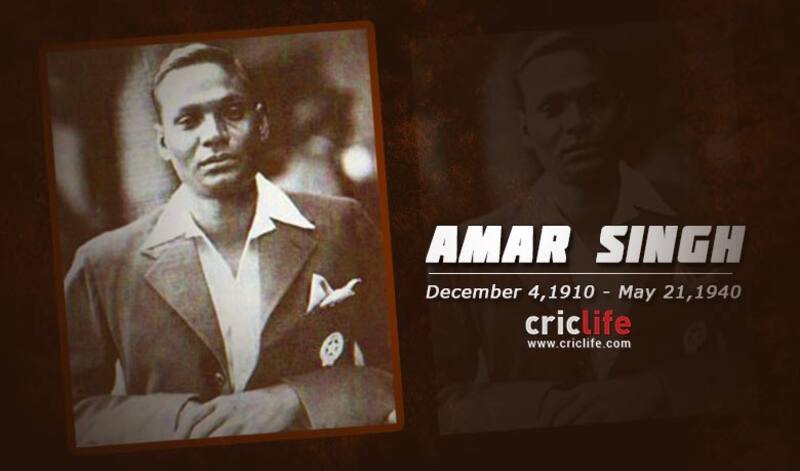This website uses cookies so that we can provide you with the best user experience possible. Cookie information is stored in your browser and performs functions such as recognising you when you return to our website and helping our team to understand which sections of the website you find most interesting and useful.
Amar Singh: 10 interesting things to know about one half of India’s first great pace bowling pair
Batsmen of no less a stature than Wally Hammond and Len Hutton were of the opinion that Amar Singh was among the greatest bowlers they had ever faced.

Ladhabhai Nakum Amar Singh, born December 4, 1910, was one of India’s greatest all-rounders. His seemingly lacklustre numbers could have been more a result of poor catching than poor bowling. Batsmen of no less a stature than Wally Hammond and Len Hutton were of the opinion that Amar Singh was among the greatest bowlers they had ever faced. Along with Mohammad Nissar, Amar Singh formed India’s first great new-ball pair. On the 105th anniversary of his birth, Shiamak Unwalla looks at 10 interesting facts about one of India’s greats.
1. India’s Test cap No. 1: Amar Singh will go down in history as India’s first Test cricketer; he was India’s first Test cap alphabetically.
2. A great partnership: Amar Singh and Mohammad Nissar have gone down in history as one of India’s greatest ever new-ball pairs. A case could be made for Kapil Dev and Manoj Prabhakar as well as Javagal Srinath and Venkatesh Prasad, but the combination of the red-hot Nissar and the crafty Amar Singh was tough to best.
3. India’s first 50: Though known primarily for his bowling, Amar Singh was also a useful lower-order batsman, capable of some big hitting. He showed his prowess with the bat in India’s first-ever Test. He scored 51 in India’s second innings, which was also the only half-century in the match by an Indian.
4. The Crack of Doom: Wally Hammond famously said of Amar Singh that he was “as dangerous an opening bowler as I have ever seen, coming off the pitch like the crack of doom.” Len Hutton revealed years later that “there is no better bowler in the world today than Amar Singh.”
5. Coaches and mentors: Though KS Ranjitsinhji never played in India (neither did his nephew KS Duleepsinhji), he almost handpicked Amar Singh for the 1932 tour; Duleep, too, intervened during the selection procedure. For Amar Singh, Ranji always remained ‘the master’. He was also coached by Frank Tarrant, but coaching was not something he needed.
6. First to 100 wickets: Amar Singh became the first cricketer to take 100 Ranji Trophy wickets. He was also the first Indian to play in the Lancashire League, turning out for Colne. He was a major star, and was seen as a rival to Nelson professional Learie Constantine. He later moved to Burnley (the Lancashire town from which James Anderson hails).
He played 89 matches for Colne in all, scoring 2,464 runs at 30.41 and taking 310 wickets at 14.18. For Burnley he played another 20, doing even better: 716 runs at 39.77 and 90 wickets at 11.16!
7. Cricketing family: Amar Singh’s older brother Ladhabhai Nakum Ramji — better known as Ladha Ramji — played just one Test for India, but had a phenomenal First-Class career. Ramji was renowned for being incredibly fast (it is unknown whether he was faster than Nissar), and had an unreal First-Class bowling average of 17.37 in 27 First-Class matches. He took 125 wickets with 5 five-wicket hauls and 3 ten-fors. He had a strike rate of merely 39.85 as well, and terrorised the opposition as he ran in with a vermillion teeka on his forehead. Amar Singh and Ramji’s nephew Vajesingh Laxman Nakum also played First-Class cricket, but with none of his uncles’ success.
8. Switching roles: Both Ramji and Amar Singh went to Alfred High School (alma mater of Mahatma Gandhi). They were spotted by Velji Master. At this stage Amar Singh was a batsman, and Ramji, a wicketkeeper. But Amar Singh was convinced by Velji Master, thanks to his physique; and Ramji wanted to emulate the express bowler Ghulam Nabi; and things changed.
9. Best figures for 18 years: When Amar Singh took 7 for 86 against England at Madras in 1934, it was the best figures by an Indian in Test cricket. The record stood for as many as 18 years before Vinoo Mankad’s 8 for 55, incidentally against the same opposition and at the same venue. However, when it comes to best figures by an Indian pacer, Amar Singh’s record stood for as many as 46 years before Kapil Dev took 7 for 56 against Pakistan at (one guess!) Madras.
10. Tragic demise: Sadly for Indian cricket, Amar Singh passed away after succumbing to typhoid at the height of his cricketing prowess, aged 29 years 169 days. He was the youngest Indian cricketer to die. The Jamsaheb of Nawanagar had provided Ramji and Amar Singh with an accommodation (the Cricketers’ Cottage); Ramji never entered the house after his brother death, and later sold it for 50,000 rupees.
TRENDING NOW
(Shiamak Unwalla is a proud Whovian and all-round geek who also dabbles in cricket writing as a reporter with CricketCountry. His Twitter handle is @ShiamakUnwalla)

